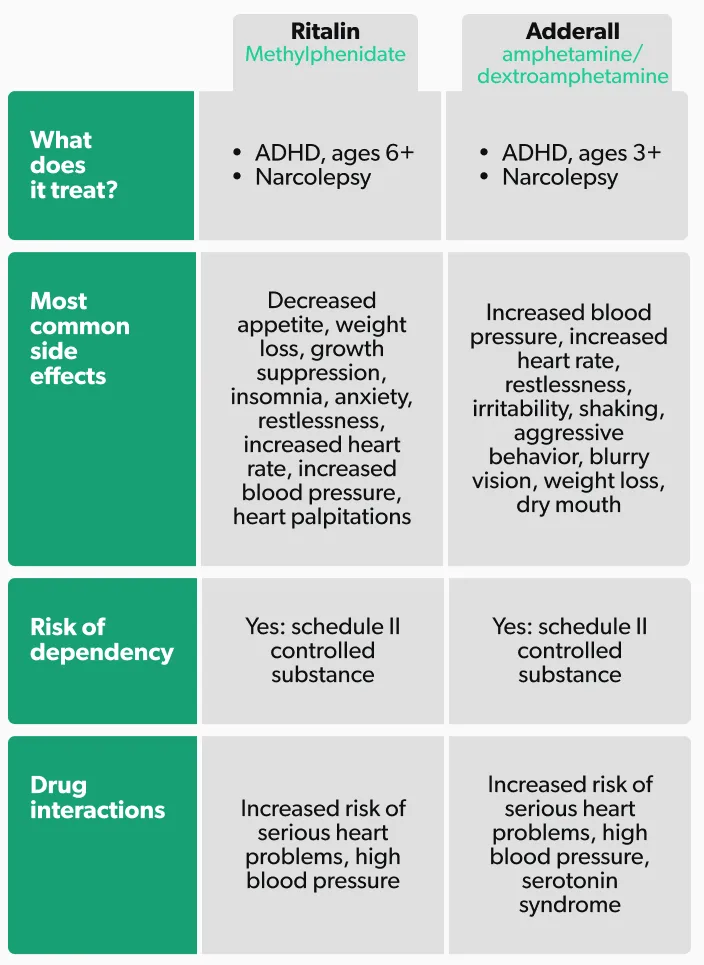Ritalin vs. Adderall: differences and similarities

Reviewed by Felix Gussone, MD, Ro,
Written by Patricia Weiser, PharmD
last updated: Aug 05, 2021
6 min read
Here's what we'll cover
Imagine that you’re a parent, trying to get your kid ready for school before you head to work. You’re running late again, and it takes you ten minutes to find your keys. Your son keeps asking when you’ll help him finish the puzzle you two started last week. When you get to the office, you realize you forgot your phone at home. At work, you feel restless, can’t sit still for very long and have difficulty focusing on your tasks. You purposely avoid your boss, who gave you a “needs-improvement” performance evaluation last month. You feel as if you get nothing done by the end of the day.
If these struggles sound familiar, and it’s been happening for at least six months, it’s a good idea to talk with your healthcare provider. It’s possible that you could have attention deficit hyperactivity disorder (ADHD), which can affect children and adults. There are treatment options available, such as behavioral therapy and prescription medications.
Read on for an overview of the differences and similarities between two medications commonly prescribed to treat ADHD: Ritalin and Adderall.
What are Ritalin & Adderall?
Ritalin (methylphenidate) and Adderall (amphetamine/dextroamphetamine) are prescription-only stimulant medications. They’re most commonly used to treat attention deficit hyperactivity disorder (ADHD) in adults, adolescents, and children.
ADHD is a behavioral condition that makes focusing on everyday tasks challenging. Childhood or adult ADHD may cause the following symptoms or behaviors (American Psychological Association, n.d.; Magnus, 2021):
Trouble paying attention or concentrating
Difficulty completing tasks
Being forgetful, disorganized, or losing things
Fidgeting or trouble sitting still
Trouble with controlling impulsive behaviors, such as suddenly taking action without thinking about it
For people with ADHD, Ritalin or Adderall can help to improve concentration and reduce impulsive behavior (Novartis, 2021-a; Teva, 2017). Ritalin and Adderall are classified as central nervous system (CNS) stimulants. These drugs are called stimulants because they speed up brain activity. They work by increasing the availability of two neurotransmitters in your brain: norepinephrine and dopamine (Farzam, 2021).
Stimulants, including Ritalin and Adderall, are classified as schedule II (two) controlled substances. According to the Drug Enforcement Administration, schedule II controlled substances are defined as drugs with a high potential for abuse. Other examples of schedule II controlled substances are fentanyl, hydrocodone, and oxycodone. Their use can potentially lead to psychological or physical dependence and addiction (DEA, n.d.).
What is Ritalin?
Ritalin is the brand-name version of the generic drug methylphenidate. The Food and Drug Administration (FDA) approved it in 1955. It comes in the following forms and strengths (Novartis, 2021-a; Novartis, 2021-b):
immediate-release tablets (Ritalin) in 5 mg, 10 mg, 20 mg
extended-release tablets (Ritalin SR) in 20 mg
extended-release capsules (Ritalin LA) in 10 mg, 20 mg, 30 mg, and 40 mg
A note about drug names: these can be confusing, especially when they’re followed by letters such as “XL” or “SR” or “LA.” There’s no set standard, but drug names followed by these letters usually stand for “sustained-release” (SR), “long-acting” (LA), or “extended-release” (XL). These medications are designed to slowly release their active ingredient into your body over some time so that their effects last longer. Immediate-release drugs release their active ingredient all at once, so their effects usually wear off sooner.
Ritalin may be taken one or more times per day. Some people with ADHD benefit from taking a dose of an extended-release form of the drug in the morning, with a dose of an immediate-release form later in the day. For example, a healthcare provider might prescribe one Ritalin LA 10-mg capsule in the morning, followed by one Ritalin 5 mg tablet late in the afternoon.
What is Ritalin used to treat?
Ritalin is FDA-approved to treat ADHD in adults and children (ages six years and older). A recent meta-analysis (a research study of multiple clinical trials) shows that methylphenidate is a first-choice treatment for ADHD in children and adolescents (Cortese, 2018).
It’s also approved to treat narcolepsy in adults. Narcolepsy is a brain condition that causes excessive daytime sleepiness. Taking stimulants may help people with narcolepsy stay more alert during the day if other treatments aren’t effective (Novartis, 2021-a; Verghese, 2021).
Off-label (not FDA-approved) uses for Ritalin include (Verghese, 2021):
To relieve fatigue (tiredness despite adequate sleep) in people fighting cancer
To treat depression in older adults (ages 65 years and older)
To improve apathy (defined as loss of motivation) in people with Alzheimer’s disease, a brain condition that gradually destroys memory and thinking skills
Your healthcare professional can tell you more about whether Ritalin is appropriate for you.
Side effects of Ritalin
All medications carry a risk of side effects. The most common side effects of Ritalin include (Novartis, 2021-a; Novartis, 2021-b):
decreased appetite
weight loss
growth suppression (in children/adolescents)
insomnia, which is trouble falling asleep or staying asleep
restlessness
increased heart rate or heart palpitations
increased blood pressure
What is Adderall?
Adderall is the brand-name version of the generic drug amphetamine/dextroamphetamine. It has two names because it contains a mixture of these two stimulant medications in one pill. The generic name of Adderall is also sometimes called “mixed amphetamines” or “amphetamine salts.” It was FDA approved in 1960. It’s available in the following forms and strengths (Teva, 2017; Adderall XR PI):
Immediate-release tablet (Adderall) in 5 mg, 7.5 mg, 10 mg, 12.5 mg, 15 mg, 20 mg, and 30 mg
Extended-release capsules (Adderall XR) in 5 mg, 10 mg, 15 mg, 20 mg, 25 mg, and 30 mg
Like Ritalin, Adderall may be prescribed one or more times per day. Some people with ADHD benefit from taking a dose of an extended-release form of the drug in the morning, plus a dose of an immediate-release form later in the day. Be sure to follow the specific dosing instructions from your healthcare provider.
What is Adderall used to treat?
Adderall is FDA-approved for treating ADHD in adults and children (three years of age and older). While Adderall is approved for children this young, most experts recommend behavioral therapy (not drug therapy) as the first step to help preschool-aged children with ADHD symptoms. Psychiatrists typically recommend adding medication if behaviors do not improve with behavioral therapy (Teva, 2017; Wolraich, 2011).
Evidence from a recent meta-analysis supports amphetamine/dextroamphetamines as the first-choice treatment for ADHD in adults (Cortese, 2018). Adderall is also FDA-approved to treat narcolepsy in adults.
Side effects of Adderall
The most common side effects of Adderall may include (Teva, 2017):
Increased blood pressure and heart rate
Restlessness
Irritability
Shaking
Aggressive behavior
Blurry vision
Weight loss
Dry mouth
Precautions: what to know before taking Ritalin or Adderall
The FDA requires stimulants, including Ritalin and Adderall, to carry several boxed warnings. Boxed warnings are the strongest type of warnings from the FDA. They alert healthcare professionals and patients about risks that they should know about before starting treatment. These warnings state (Novartis, 2021-a; Teva, 2017):
CNS stimulants, including methylphenidate and amphetamines, have a high potential for abuse and dependence.
Taking stimulants more than prescribed or for a non-legit purpose could result in dangerous effects, including life-threatening heart problems such as heart attack
Because of these risks, your doctor will monitor you after you start treatment to check for any signs of heart problems, such as increased blood pressure. They’ll work with you to adjust your treatment plan, sometimes by trial and error, until they find the lowest dose that’s effective for you.
Drug interactions
Ritalin and Adderall have some of the same drug interactions, but also some that are different. If you’re taking Ritalin or Adderall, it’s always a good idea to consult your pharmacist or healthcare provider before taking any new medications, including over-the-counter and prescription drugs or herbal supplements.
Both Ritalin and Adderall should not be taken at the same time or within 14 days of stopping a type of drug known as a monoamine oxidase inhibitor (MAOI) because of the risk of hypertensive crisis, a medical emergency in which blood pressure becomes dangerously elevated.
The following medications can interact with Ritalin and increase the risk of side effects such as increased blood pressure (Novartis, 2021-a):
Ritalin can interact with certain types of anesthesia drugs. Ask your healthcare provider whether you should temporarily stop taking Ritalin before a scheduled surgery.
Ritalin can reduce the effectiveness of medications used to treat hypertension (high blood pressure)
Taking risperidone (Risperdal), a medication for schizophrenia and other mental health disorders, with Ritalin can cause side effects such as uncontrolled movements or tics.
Several medications can interact with Adderall, including (Teva, 2017):
Some medications can increase the risk of serotonin syndrome with Adderall. A few examples include SSRIs, tricyclic antidepressants, and triptan migraine medications.
Certain medications can make Adderall less effective, such as:
haloperidol (Haldol)
ascorbic acid (a form of vitamin C)
Certain drugs can raise the levels of Adderall in your body, worsening its side effects, such as:
sodium bicarbonate
acetazolamide
some thiazide diuretics
Similarities and differences of Ritalin vs. Adderall
We’ve given you a lot of information regarding the differences and similarities between these two stimulant medications. Here is a summary:

DISCLAIMER
If you have any medical questions or concerns, please talk to your healthcare provider. The articles on Health Guide are underpinned by peer-reviewed research and information drawn from medical societies and governmental agencies. However, they are not a substitute for professional medical advice, diagnosis, or treatment.
American Psychological Association. (n.d.). ADHD. Retrieved from https://www.apa.org/topics/adhd
Cortese, S., Adamo, N., Del Giovane, C., Mohr-Jensen, C., Hayes, A. J., Carucci, S., et al. (2018). Comparative efficacy and tolerability of medications for attention-deficit hyperactivity disorder in children, adolescents, and adults: a systematic review and network meta-analysis. The Lancet. Psychiatry, 5 (9), 727–738. doi: 10.1016/S2215-0366(18)30269-4. Retrieved from https://www.ncbi.nlm.nih.gov/pmc/articles/PMC6109107/
Drug Enforcement Agency (DEA). (n.d.). Drug scheduling. Retrieved from https://www.dea.gov/drug-information/drug-scheduling
Farzam, K., Faizy, R. M., & Saadabadi, A. (2021). Stimulants. [Updated May 28, 2021]. In: StatPearls [Internet]. Retrieved from https://www.ncbi.nlm.nih.gov/books/NBK539896/
Magnus, W., Nazir, S., Anilkumar, A. C., et al. (2021). Attention deficit hyperactivity disorder. [Updated Jul 1, 2021]. In: StatPearls [Internet]. Retrieved from https://www.ncbi.nlm.nih.gov/books/NBK441838/
Novartis. (2021). Ritalin (methylphenidate hydrochloride) tablets, for oral use, CII. Ritalin-SR (methylphenidate hydrochloride extended-release) tablets, for oral use, CII. Retrieved from https://www.accessdata.fda.gov/drugsatfda_docs/label/2021/010187s093lbl.pdf
Teva Pharmaceuticals USA. (2017). Adderall CII (dextroamphetamine saccharate, amphetamine aspartate, dextroamphetamine sulfate and amphetamine sulfate tablets). Retrieved from https://www.accessdata.fda.gov/drugsatfda_docs/label/2017/011522s043lbl.pdf
Verghese, C. & Abdijadid, S. (2021). Methylphenidate. [Updated May 4, 2021]. In: StatPearls [Internet]. Retrieved from https://www.ncbi.nlm.nih.gov/books/NBK482451/
Wolraich, M., Brown, L., Brown, R. T., DuPaul, G., Earls, M., Feldman, H. M., et al. (2011). ADHD: clinical practice guideline for the diagnosis, evaluation, and treatment of attention-deficit/hyperactivity disorder in children and adolescents. Pediatrics, 128 (5), 1007–1022. doi: 10.1542/peds.2011-2654. Retrieved from https://www.ncbi.nlm.nih.gov/pmc/articles/PMC4500647/










